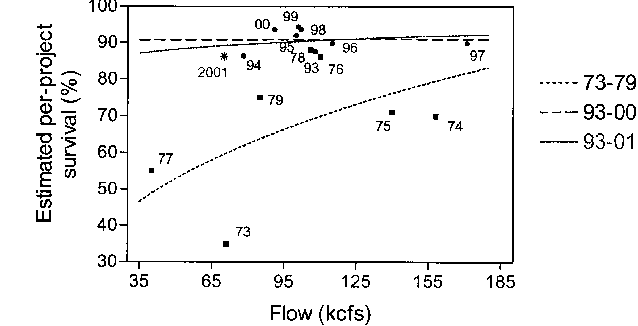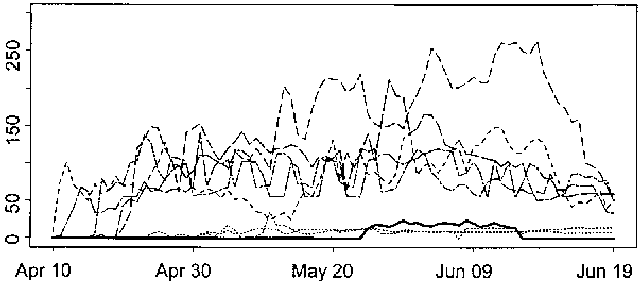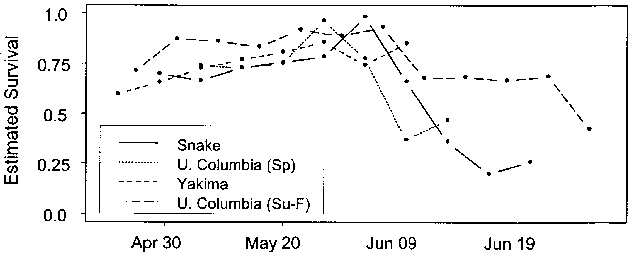|
Did the Dams
Slaughter Salmon This Spring? The federal government fields an army of enviro-doomsayers that collectively have raised electricity rates in the Pacific Northwest to all-time highs because of the enormous hidden taxes they impose upon the Federal Columbia River Power System and other hydroelectric dams in the Pacific Northwest. One general in this army, so to speak, is the Fish Passage Center, which develops quasi-scientific "proof" of harms allegedly imposed by dams. Earlier this year, with low water conditions in the Columbia Basin, the Center and its minions worked overtime to flood the media with claims that the dams were exterminating salmon. Their "proof" also serves as ammunition for a favorite battle of environmentalists -- resort to courts that no longer care about the truth of enviro claims, but rush blindly to join the Great Cause of Saving The Environment. Thus Northwest newspapers recently reported "BPA sued over 'salmon massacre' water policy". As usual, the lawsuits, and indeed the Crusade in general, are premised on lies. The first big lie is one of omission. Neither the Fish Passage Center, the enviros, or their fellow travelers in the media generally bother to report that dam operators offset the effects of poor water conditions -- imposed by Nature -- by barging most the fish downriver. For example, 93% and 95%, respectively, of Snake River chinook and steelhead were collected and put on barges this year. A sentinent salmon offered the choice of migrating through hundreds of miles of river at the mercy of birds and predatory fish or barge passage would choose barge passage, and be rewarded with better-than-natural survival. We made the choice for the salmon, and one could kill off all the juvenile salmon left in the river and it would still be a good migration year for juvenile salmon, so to speak. The second big lie is also one of omission. No one mentions that with lower flows and lower spill, adult passage conditions appear to have improved substantially. In recent years, as biologists have ignored operational criteria for adult fish ladders in favor of "spill über alles", only 85% of the adults have made it upriver past the four Lower Snake River Dams. This year, as power emergencies shut down spill at these dams, more than 98% of the fish made it up river. Fish managers have never bothered to balance minor benefits from spill for juveniles against significant adverse effects on adults. Each adult is, of course, worth thousands of juveniles insofar as the population dynamics of salmon are concerned. Third big lie, and most subtle one, is the unstated assumption that each and every fish that dies in the river dies because of dams. Juvenile survival in the river did drop significantly this year, but that says nothing whatsoever about the effects of dams. Before reason collapsed in the face of the True Faith That Dams Are Evil, one would have to show a causal connection between some effect arising from the dams and the deaths of the fish before serving up conclusions to the public. That is proof is very hard to obtain, however, because the effects of the dams are so small. Years ago, one study showed that the condition of incoming fish was one of the strongest factors predicting survival downstream through the dams and reservoirs, and since then, the "fish condition" factor has been studiously ignored in most research. Were fish entering the dams and reservoirs this year in worse shape? No one bothers to ask. Warmer temperatures can unquestionably kill fish, but the peak temperatures of the river would be higher without dams. No one has attempted to predict what proportion of reduced survival is related to temperature either. And with lower flows, the water is much clearer allowing the birds protected by Judge Rothstein and the Audubon Society to ravage the migrating juveniles. Researchers have pointed out that with so many fish in barges, the few remaining in-river fish probably faced worse odds from the jaws of hungry predators. While the parade of lies in the media continues unabated, researchers at NMFS have produced a ninety-five page analysis entitled "Survival Estimates for the Passage of Spring-Migrating Juvenile Salmonids through Snake and Columbia River Dams and Reservoirs, 2001". This paper constitutes yet another nail in the coffin of the flow-survival hypothesis. Federal water management policy is driven by two data points from 1973 and 1977, illustrated below in a chart from the paper. Fish biologists assume that we can magically manufacture more fish by taking water from farmers and hydropower operators, and dumping it down the river to increase salmon survival by "moving us up the curve". With the low flows in 2001, it becomes even more apparent that whatever was going on in the 1970s has no application to modern river operations. There is essentially no relationship between flow and survival, except at flows far lower than 2001 flows. Unfortunately, the flow-survival hypothesis is constantly re-animated by the voodoo biologists who fill the halls of the federal agencies.
The NMFS investigators also focused closely on the question of benefits from spill at hydropower dams. This year's spill operations were confined to a discrete burst of spill that provided a test case for attempting to measure benefits from the spill. Below is a chart from the paper showing the amount of spill over the last few years at John Day Dam; 2001 spill is the dark line at the bottom of the graph.
As you can see, spill was concentrated in a narrow band in late May and early June, providing an opportunity to test whether the survival of juvenile salmon migrating downstream in experienced higher survival during this time frame. Here is the data for several stocks of salmon (survival from McNary tailrace to John Day tailrace), which is inconclusive. While there appears to be a continuation of the upward trend during the spill there is also a sharp drop-off in the second half.
The NMFS researchers tried sophisticated statistical tests to attempt to demonstrate the benefits of spill, but came up empty-handed. Five sample stocks showed slightly higher survival during the spill period, and two showed lower survival, hardly a ringing endorsement of spill. More importantly, these tests were conducted as if spill were the only factor influencing salmon survival, not temperature, fish condition, water clarity, or any other factor. The Region waits in vain for a comprehensive analysis that would explore the relative significance of all these factors, a comprehensive analysis that would probably demonstrate that any more than minimal spill is mere background noise in the factors affecting the survival of juvenile salmon. © James Buchal, December 26, 2001 You have permission to reprint this article, and are encouraged to do so. The sooner people figure out what's going on, the quicker we'll have more fish in the rivers. |


